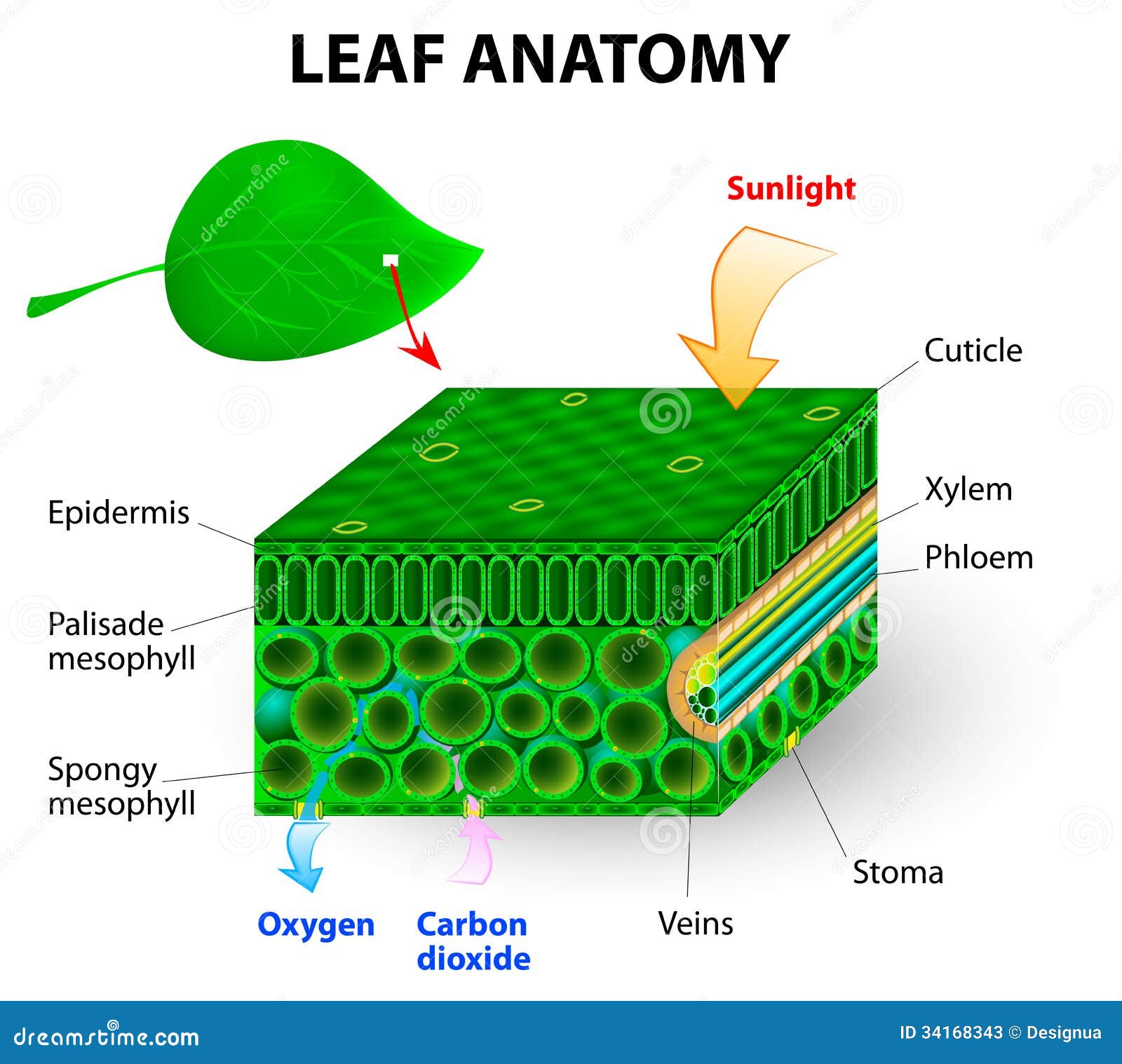:max_bytes(150000):strip_icc()/leaf_crossection-57bf24a83df78cc16e1f29fd.jpg)
Plant Leaves and Leaf Anatomy
Students use this to label their own blank leaf diagram. What are the parts of a leaf? - Blade - Tip - Petiole - Midrib - Vein - Margin - Stipules. How will this activity be useful? This is a great way to introduce your students to plants and learn to think like scientists. They could use the poster to compare and contrast the parts of.
Cross Section of a Leaf Labelled diagram
The midrib contains the main vein (primary vein) of the leaf as well as supportive ground tissue (collenchyma or sclerenchyma). Figure 3.4.1. 1: A typical eudicot leaf. Many leaves consist of a stalk-like petiole and a wide, flat blade (lamina). The midrib extends from the petiole to the leaf tip and contains the main vein.

Label A Leaf Diagram diagramwirings
Like the stem, the leaf contains vascular bundles composed of xylem and phloem (Figure 3.4.2.6 − 7 3.4.2. 6 − 7 ). When a typical stem vascular bundle (which has xylem internal to the phloem) enters the leaf, xylem usually faces upwards, whereas phloem faces downwards. The conducting cells of the xylem (tracheids and vessel elements.

Parts of a Leaf YouTube
Parts of a Leaf Diagram 1. Petiole It is the stalk that connects a leaf to the stem of the plant, it is made of complex conducting tissues called vascular tissues. Functions Providing support to the leaf and keeps it erect Transporting water and nutrients absorbed by the roots to the leaves

Leaf anatomy stock illustration. Illustration of lower 34168343
The photo on the left is a palmate leaf, the diagram on the right is a pinnate leaf. Photo by Maria Morrow, CC-BY 4.0. Diagram on the right from Chapter 3.4.2, Botany, by Algiers, Ha, and Morrow.. CC-BY 4.0 with labels added. Alternate Leaf Arrangement. In alternate leaf arrangement, one leaf emerges per node, giving the appearance of.

Leaf Structure & Evolution Digital Atlas of Ancient Life
The leaf blade is composed of tissue layers, each having an important part to play in a functioning leaf. Find these structures on the attached diagram of cellular leaf tissues.

Leaf Structure Labeled Best Science Images and diagrams Pinterest Science images
The air space found between the spongy parenchyma cells allows gaseous exchange between the leaf and the outside atmosphere through the stomata. In aquatic plants, the intercellular spaces in the spongy parenchyma help the leaf float. Both layers of the mesophyll contain many chloroplasts. Figure 30.10. 1: Mesophyll: (a) (top) The central.
:max_bytes(150000):strip_icc()/parts_of_a_leaf-56abaed23df78cf772b5625a.jpg)
Plant Leaves and Leaf Anatomy
Each leaf typically has a leaf blade called the lamina, which is also the widest part of the leaf.Some leaves are attached to the plant stem by a petiole.Leaves that do not have a petiole and are directly attached to the plant stem are called sessile leaves. Small green appendages usually found at the base of the petiole are known as stipules.Most leaves have a midrib, which travels the length.

Labeled Diagram Of A Leaf
Definition of a Leaf: The leaf is a flattened, lateral outgrowth of the stem in the branch, developing from a node and having a bud in its axil. It is normally green in colour and manufactures food for the whole plant. The leaves take up water and carbon dioxide and convert them into carbohydrates in the presence of sunlight and chlorophyll.

Label the following diagram of a leaf. Brainly.in
Leaf Cross Section Diagram Label Me! Printout Read the definitions then label the cross section of the leaf. Answers: Leaf Structure and Function: Printable Read-and-Answer Worksheet A printable worksheet on leaves, with a short text, a cross section of a leaf to label, and questions to answer. Or go to the answers. Plant Anatomy Label Me! Printout

Plant Leaf Drawing at GetDrawings Free download
Definition. Lower part of leaf with air spaces in between each cell- allows carbon dioxide and oxygen to diffuse. Location. Term. Vein. Definition. consists of xylem and phloem - transports water to chloroplasts, transports sugar to the rest of the plant cells to be stored or used as energy. Location. Term.

Leaf Labelled Stock Photo Download Image Now iStock
They are attached by a continuous vascular system to the rest of the plant so that free exchange of nutrients, water, and end products of photosynthesis (oxygen and carbohydrates in particular) can be carried to its various parts. Leaves are initiated in the apical bud (growing tip of a stem) along with the tissues of the stem itself.

Draw a labelled diagram of the external structure of a leaf. Brainly.in
GCSE WJEC Structure of plants - WJEC Leaf structure Plants adapt in order to efficiently collect raw materials required for photosynthesis. These raw materials must be transported through the.
leaf structure Labelled diagram
A leaf is a highly organized factory - an organ constructed of several kinds of specialized tissues, each of which has its own duties.

Changing Seasons, Fall Leaves, and Your Car's Paint
Help your learners identify the various parts of a leaf with this handy activity. It includes a labelled poster, which could also be displayed on your classroom wall. Students use this to label their own blank leaf diagram. What are the parts of a leaf? - Blade - Tip - Petiole - Midrib - Vein - Margin - Stipules. How will this activity be useful?

Leaf anatomy vector illustration diagram Aulas de biologia, Educação, Anatomia
Label the Parts of a Leaf by m1cha8l 9,934 plays 10 questions ~30 sec English 10p More 6 3.60 (you: not rated) Tries Unlimited [?] Last Played November 14, 2023 - 03:03 am There is a printable worksheet available for download here so you can take the quiz with pen and paper. Remaining 0 Correct 0 Wrong 0 Press play! 0% 0:00.0